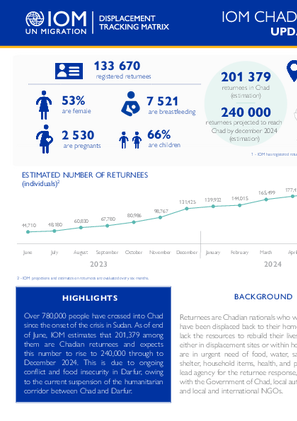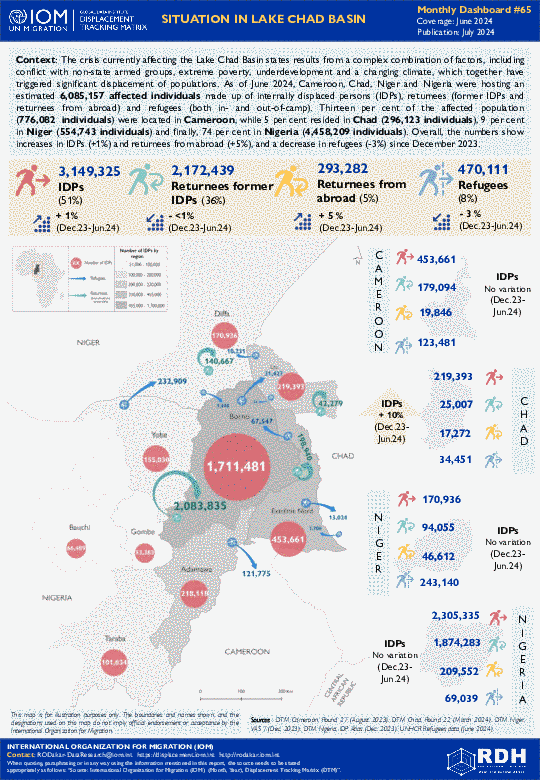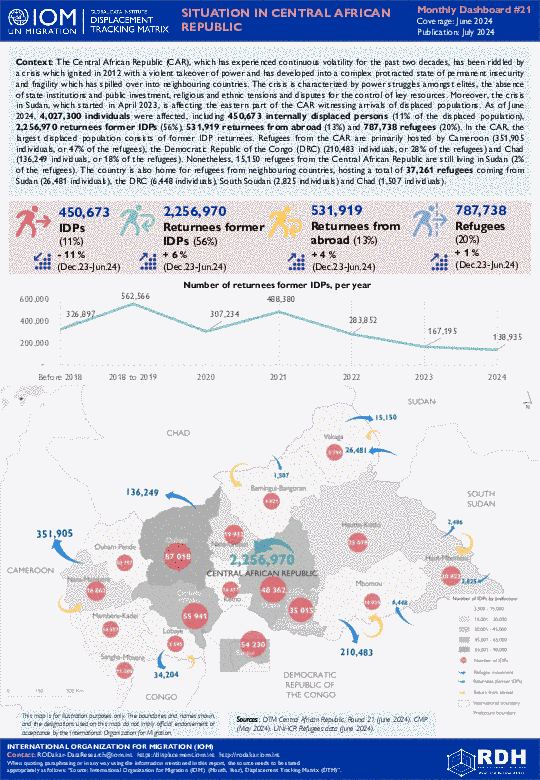-
Countries
-
Data and Analysis
-
Special Focus
-
Crisis Responses
Dashboard/Fact Sheet
Color
-

Contact
DTM Chad, dtmtchad@iom.int
Language
English
Location
Chad
Period Covered
Jul 09 2024
Jul 09 2024
Activity
- Mobility Tracking
- Event Tracking
Over 780,000 people have crossed into Chad since the onset of the crisis in Sudan. As of end June 2024, IOM estimates that 201,379 among them are Chadian returnees and expects this number to rise to 240,000 through to December 2024. This is due to ongoing conflict and food insecurity in Darfur, owing to the current suspension of the humanitarian corridor between Chad and Darfur.
Returnees are Chadian nationals who were living in Sudan and have been displaced back to their home country where they lack the resources to rebuild their lives. Returnees are living either in displacement sites or within host communities. They are in urgent need of food, water, sanitation and hygiene shelter, household items, health, and protection. IOM is the lead agency for the returnee response, in close coordination with the Government of Chad, local authorities, UN agencies, and local and international NGOs.

Contact
DTM Libya, DTMLibya@iom.int
Language
English
Location
Libya
Snapshot Date
Jun 30 2024
Activity
- Survey
- Flow Monitoring Survey
- Flow Monitoring
This profile provides information on the most recent migration dynamics between Pakistan and Libya as well as the sociodemographic characteristics of Pakistani migrants and information on the routes they travelled to reach Libya.

Contact
DTM Libya, DTMLibya@iom.int
Language
English
Location
Libya
Snapshot Date
Jun 30 2024
Activity
- Survey
- Flow Monitoring Survey
- Flow Monitoring
This profile provides information on the most recent migration dynamics between Bangladesh and Libya as well as the sociodemographic characteristics of Bangladeshi migrants and information on the routes they travelled to reach Libya.

Contact
DTMAfghanistan@iom.int
Language
English
Location
Afghanistan
Period Covered
Jun 30 2024
Jul 06 2024
Activity
- Survey
- Flow Monitoring Survey
- Flow Monitoring
The IOM Afghanistan’s DTM Flow Monitoring activity is designed to provide insights into the mobility patterns at Afghanistan’s border points with the Islamic Republic of Iran and Pakistan. The activity involves two interlinked exercises: the Flow Monitoring Counting (FMC), a headcount of individuals crossing the border, and the Flow Monitoring Surveys (FMS), which collect data on the profiles and intentions of randomly selected Afghan nationals. DTM FM is operational at four main crossing points (connected to Afghanistan’s National Highway) as well as six other crossing points with Islamic Republic of Iran and Pakistan. This weekly snapshot combines information from the FM activity and various IOM sources related to cross-border movement. For a detailed explanation of the methodology used in gathering this data, the report directs readers to the section titled “IOM INFLOW DATA” on the last page.
The Central Sahel area, and in particular the Liptako Gourma region, which borders Burkina Faso, Mali and Niger, is affected by a complex crisis involving growing competition over dwindling resources; climatic variability; demographic pressure; high levels of poverty; disaffection and a lack of livelihood opportunities; communal tensions; the absence of state institutions and basic services; and violence related to organized crime and non-state armed groups. The crisis has triggered significant displacement of populations in the concerned countries and is affecting neighbouring countries such as Mauritania and the coastal countries.
As of June 2024, 3,125,192 individuals have been displaced, including 2,616,570 internally displaced persons (84% of the displaced population) and 508,622 refugees (16% of the displaced population). Sixty-seven per cent of the displaced populations (2,101,107 individuals) were located in Burkina Faso, while 14 per cent resided in Mali (422,862 individuals), 11 per cent in Niger (353,145 individuals) and 4 per cent in Mauritania (119,354 individuals). The crisis’ recent spill over to coastal countries, namely Côte d’Ivoire, Ghana, Togo and Benin, shows growing number of refugees coming from the Central Sahel and populations internally displaced. As of June, 128,724 individuals were affected by displacement within the four countries (22,613 in Benin, 52,365 in Côte d’Ivoire, 7,230 in Ghana and 46,525 in Togo) of which 34,088 were internally displaced.
The crisis currently affecting the Lake Chad Basin states results from a complex combination of factors, including conflict with non-state armed groups, extreme poverty, underdevelopment and a changing climate, which together have triggered significant displacement of populations.
As of June 2024, Cameroon, Chad, Niger and Nigeria were hosting an estimated 6,085,157 affected individuals made up of internally displaced persons (IDPs), returnees (former IDPs and returnees from abroad) and refugees (both in- and out-of-camp). Thirteen per cent of the affected population (776,082 individuals) were located in Cameroon, while 5 per cent resided in Chad (296,123 individuals), 9 per cent in Niger (554,743 individuals) and finally, 74 per cent in Nigeria (4,458,209 individuals). Overall, the numbers show increases in IDPs (+1%) and returnees from abroad (+5%), and a decrease in refugees (-3%) since December 2023.
The Central African Republic (CAR), which has experienced continuous volatility for the past two decades, has been riddled by a crisis which ignited in 2012 with a violent takeover of power and has developed into a complex protracted state of permanent insecurity and fragility which has spilled over into neighbouring countries. The crisis is characterized by power struggles amongst elites, the absence of state institutions and public investment, religious and ethnic tensions and disputes for the control of key resources. Moreover, the crisis in Sudan, which started in April 2023, is affecting the eastern part of the CAR witnessing arrivals of displaced populations.
As of June 2024, 4,027,300 individuals were affected, including 450,673 internally displaced persons (11% of the displaced population), 2,256,970 returnees former IDPs (56%), 531,919 returnees from abroad (13%) and 787,738 refugees (20%). In the CAR, the largest displaced population consists of former IDP returnees. Refugees from the CAR are primarily hosted by Cameroon (351,905 individuals, or 47% of the refugees), the Democratic Republic of the Congo (DRC) (210,483 individuals, or 28% of the refugees) and Chad (136,249 individuals, or 18% of the refugees). Nonetheless, 15,150 refugees from the Central African Republic are still living in Sudan (2% of the refugees). The country is also home for refugees from neighbouring countries, hosting a total of 37,261 refugees coming from Sudan (26,481 individuals), the DRC (6,448 individuals), South Soudan (2,825 individuals) and Chad (1,507 individuals).

Contact
DTM Libya, DTMLibya@iom.int
Language
English
Location
Libya
Snapshot Date
Jun 30 2024
Activity
- Survey
- Flow Monitoring Survey
- Flow Monitoring
This profile provides information on the most recent migration dynamics between Niger and Libya as well as the sociodemographic characteristics and vulnerabilities of Nigerien migrants in Libya, including their level of access to healthcare and employment conditions.

Contact
iomnigeriadtm@iom.int
Language
English
Location
Nigeria
Period Covered
Jul 01 2024
Jul 07 2024
Activity
- Mobility Tracking
- Event Tracking
On 01, 03 and 04 July 2024, communal clashes occured in the community of Aila in Egba ward of Agatu local government area (LGA), armed bandits attacked the community of Samco Community in Borikyo ward of Ukum LGA and heavy rainfall occurred in the community of Achusa Market in Bar ward of Makurdi LGA all in Benue State. There were reports of 78 injuries and 28 fatalities. The attacks displaced 618 individuals in 135 households from Aila community to Obagaji host community in Obagaji ward. The affected individuals included 851 children, 387 women and 297 men.
On 04 and 06 July 2024, armed bandits attacked Model Primary School Camp in Gwadabawa ward of Gwadabawa LGA in Sokoto State and a communal clash occurred in the community of Sabuwar Unguwa in Wakili Kudu 3 ward of Katisna LGA in Katsina State. There were reports of 39 injuries and six fatalities. The affected individuals included 1,069 children, 549 women, and 304 men.
Of all the needs identified, food, non-food items (NFI), WASH, and transport were the most prevalent. Other needs included shelter, psychosocial support, and health.
Following these events, DTM (Displacement Tracking Matrix) field staff conducted rapid assessments to inform the humanitarian community and Government/partners, and to enable a targeted response.
Nigeria’s north-central and north-west zones are afflicted with a multi-dimensional crisis. Long-standing tensions between ethnic and religious groups often result in attacks and banditry or hirabah. These attacks involve kidnapping and grand larceny along major highways by criminal groups. During the past years, the crisis accelerated and has resulted in widespread displacement across the north-central and north-west regions.

Contact
DTM Somalia, IOMSomaliaDTM@iom.int
Language
English
Location
Somalia
Period Covered
Apr 01 2024
Apr 30 2024
Activity
- Flow Monitoring
- Flow Monitoring Registry
IOM Somalia DTM’s flow monitoring team tracks migrant movements at seven active Flow Monitoring Points (FMPs) along the border with Ethiopia, Kenya, and Djibouti and at Bossa FMP on the coast. Enumerators stationed at FMPs register migrant entries and exits to detect different migration patterns, and to provide numerical estimates to help estimate the population of irregular migrants who enter and exit the country. Flow monitoring does not capture all flows into and out of Somalia and should be seen as only indicative of migration trends of the unknown total number of migrants who move in and out of Somalia at FMPs during the indicated time frame.
A total of 22,611 movements were observed in April 2024, representing a 16% decrease compared to March 2024 when 26,793 movements were observed during this period. Comparing April 2024 with March 2024, Doolow (-25%), Lowyacado (-8%), Harirad (-6%), Dhobley (-4%) , Bossaso(-3%) and Cabudwaaq (-2%) FMPs recorded a decrease in movements while Buuhoodle (5%) FMP recorded an increase in movements.
Doolow (57%), Bossaso (28%), and Dhobley (7%) FMPs recorded the highest numbers of incoming movements, while Doolow (31%), Dhobley (27%) and Cabudwaaq (18%) recorded the highest numbers of outgoing movements for April 2024.
Pagination
- Previous page
- Page 2
- Next page


